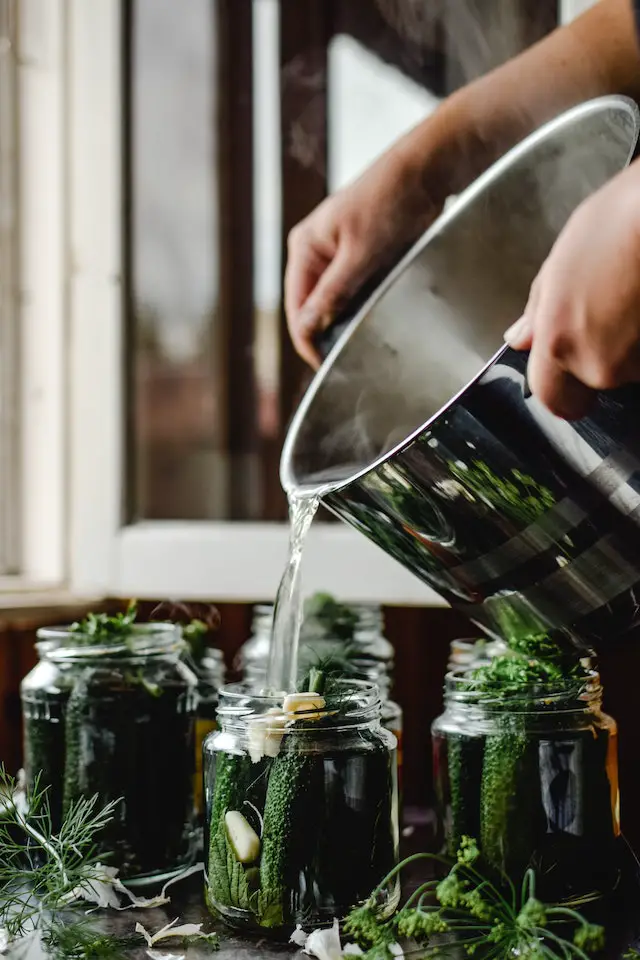There are three main cultivar groups of cucumber all of which can be used for pickling.
Of the three main cultivar groups however, one specific group stands out completely above the rest when it come to pickling, and that is the “pickle cucumber”.
This cultivar group have members with shorter lengths than the rest of the two cultivar groups which makes them easy to fit into pickling jars. The length ranges between 2.5 to 13 cm.
They also have thick bodies, lack voids in their flesh to give that full and satisfying bite, and also have really bumpy skins.
The other two cultivar groups of cucumbers include the slicing cucumber which is meant to be sliced into salads and eaten fresh, and the burpless cucumber which are a type of slicing cucumbers that are grown to be nearly seedless and have a taste that is much sweeter than all other cultivar groups of cucumbers.
Both the slicing and burpless cucumbers can be used successfully to make pickles, but they will have to be chopped or sliced due to their very large sizes.
In the rest of this article, you’ll learn how to make a pickle out of a pickle cucumber as well as out of the other varieties of cucumbers.

How do you pickle “pickle cucumbers”?
Pickling the pickle cucumbers is very easy and requires a bit less preparation than when using slicers and burpless cucumbers.
To begin, here are the ingredients you need
- 4 pounds of picklers
- 8 cloves of garlic
- 8 heads of fresh dill
- 8 bay leaves
- 2 quarts white vinegar (4 -6% acidity)
- 1/2 cup pickling salt or kosher salt
- 2 quarts of water
- 8 jars
Start off with really fresh, young and injury free cucumbers that are nearly all the same size to make the pickling even.
Proceed to wash them thoroughly using a vegetable brush under running water to get rid of any dirt on them which can cause spoilage of the pickling juice or brine. Take your time to also cut off the blossom ends which will make the cucumbers soft during pickling and leave about 1/2 inch of stem on them.
Clean 8 pickling glass jars under running water. You don’t need to sterilize them but if you want to, then you can go ahead. Make sure to inspect the jars and the seals for any dents and cracks which can tamper with pickling efforts.
Next, stuff cucumber into the jars along side one garlic, one bay leaf and one head of fresh dill per jar.
Afterwards, prepare the brine mixture by combining 2 quarts of water, vinegar and salt mixture in a wide pot and bring to a boil while stirring to make sure all of the salt dissolves.
Carefully pour the brine mixture into the jars and make sure to leave a 1/4 inch head space. Use a spatula really thin to release air bubbles that may have been trapped in the mixture which will cause spoilage during pickling.
Make sure that the cucumbers at the top are fully submerged to prevent mold growth during storage.
Next, wipe around the rim of the jar and the inside 1/4 head space and the lid the jar.
Then comes water bath processing which is a necessary in order to deactivate bacteria or organism that can cause spoilage during storage, and also deactivation of enzymes that will cause quick deterioration for the cucumbers.
To do the water bath processing, fill up water in a stock pot and bring it to a boil, then add in the jars and begin counting immediately until 10 minutes expire, after which, you take them out from the water and place them on a towel on the counter and let cool.
After they cool, test the seal by trying to lift it off. If you encounter some resistance, then the seal is perfect, otherwise, refrigerate the pickle, let them sit for 2 weeks there and begin to dig into them. Make sure unsealed jars do not stay in the refrigerator for more than 2 months.
For the sealed pickles, let them sit undisturbed on the counter for 24 to 48 hours to really get the seal to hold, then transfer them to a cool dry place and store for 4-6 weeks before eating.
Once opened, transfer them to the refrigerator and consume within a week.
An alternative to this method is the fermentation method that produce cucumbers that are fermented naturally using bacteria naturally present on the surface of the cucumber.
Quick notes:
- White vinegar is recommended to give the pickle a clear color. If that isn’t something that interests you, then you can go ahead and pickle using the apple cider vinegar which will impart a very rich flavor to the pickles as well as some colors.
- It is important to use pickling salt as other types of salts have impurities or elements that can affect the pickling procedure.
Can you pickle large cucumbers?
For the slicing and burpless cucumbers that are larger than the pickles, you will need to cut them into half widthwise or cut them into 2-3 cm slices. All other procedure is the same.
Of course, you can pickle bitter cucumbers, but expect a slight variation when it comes to the flavors of the brine as well as that of the pickles.
Can you pickle bitter cucumbers?
There are techniques that may help you get rid of the bitterness of cucumbers. Simply cut them in half widthwise, then lengthwise so you end up with four pieces of cucumber. The add salt to the center of each half containing the seeds and water, and turn them upside down to sit for an hour. Afterwards, scoop out the middle using the tip of the spoon and go ahead an pickle the cucumbers.
Can you pickle overripe cucumbers or those that have turned yellow?
Yes, it’s possible to pickle overripe cucumbers. The procedures for pickling overripe cucumbers is similar to that for pickling fresh young cucumbers, but you might have better success (in terms of texture) cutting the cucumbers into slices rather than pickling them whole.
Can you pickle cucumber without the skin?
You can pickle cucumbers whole, cut in halves lengthwise or widthwise, diced, sliced into round shapes of thickness varying from 2-4 cm or even peeled. All of them work great in a pickle juice. With a skin-on cucumber however, you might have extra crunch on your pickle than when you remove the peels prior to pickling.

